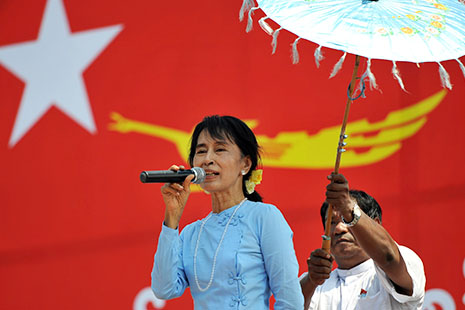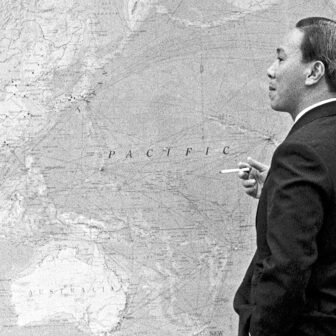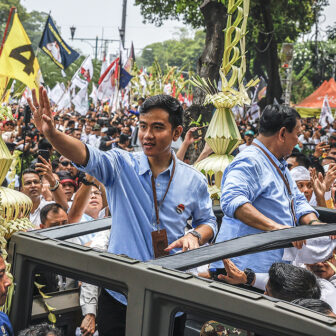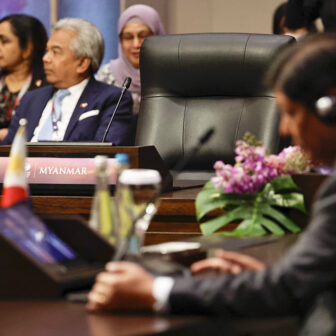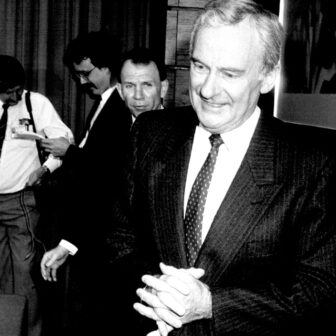SINCE the coup of 2 March 1962, tens of millions of Burmese have grown old waiting for the army to surrender power. Many saw their dreams derailed by the grim realities of life under Southeast Asia’s most frequently denounced pariah regime. Long years of economic stagnation, day-to-day demoralisation and heavy-handed crackdowns left their mark.
Now, as hard as it might be to believe, direct military rule in Burma is coming to an end. Although hardship and frustration continue, there is no doubt Burma’s fortunes are changing. With a tailor-made 2008 constitution securing its immediate future and the parliamentary system tilted heavily in its favour, the military leadership is gradually relaxing its stranglehold. Even with the lingering prospect that many things could go wrong, the mood is fresh, even hopeful.
Burma’s leaders, especially President Thein Sein, are working to regularise relations with the rest of the world, remove the significant obstacles to trade and investment, and develop a more broadly prosperous and peaceful society. This transformation of a thoroughly entrenched military dictatorship is the culmination of long-awaited, and frequently delayed, moves towards greater respectability.
Former generals who’ve carved out military careers estranged from the usual opportunities for engagement now greet long queues of well-wishers and Western dignitaries. After two decades of snug relations with China and links with outcasts such as North Korea, a more diverse circle of friends has emerged. With this happening in a political system where isolationism and paranoia have usually trumped pragmatism and innovation, the shock to Western audiences has been palpable. Burma, an exemplar of quirky authoritarian practices and steel-willed despots, is becoming more familiar by the day.
Naturally, its government has no immediate plans for a system of political, social and economic organisation that will pass muster with its harsher critics. Inevitably, a chorus will continue to decry human rights abuses, ethnic conflicts and popular disenfranchisement, sad facts that will remain part of Burmese life for years to come.
But what is changing is more fundamental. Soon Burma will not be so different to the many other Southeast Asian countries in which Western governments are prepared to support substantial investments and develop cosy ties.
The difference in Burma has always been Aung San Suu Kyi, global democracy icon and courageous fighter for human rights. Her popularity with Western politicians and activists, not to mention the mandate she received from the Burmese people in the 1990 election, has ensured that while her liberty was at stake there could be no compromise.
Suu Kyi is now poised to take a seat in parliament after a by-election next month to replace representatives who have taken ministerial posts. If everything goes to plan, she will soon be working for the first time as an elected parliamentarian. Her triumph at the polls will be greeted by joyous celebrations.
She is now a regular participant in public discussion. Her movements, and her political campaigns, are reported in Burma’s media. The shining light of the democracy movement is mentioned directly, and warmly, by senior government officials. Her house on University Avenue is surrounded by new security; gone are the sentries and intelligence agents that made her neighbourhood off-limits. Even the decrepit road out front has been refurbished.
Photos of her and her father, the slain independence hero General Aung San, now proliferate. There is a new and genuine openness about her role, and an emerging consensus that her election in the April poll is guaranteed. For the first time in history, Burma’s military-dominated leadership will more than tolerate her presence – they are actively embracing it.
But with all of these positive changes in mind, it’s important to remember that the current transition has more to do with securing the military’s future than with Suu Kyi’s charismatic activism.
The ruling generals are no longer young, and they acknowledge that their stale dictatorship is due for a comprehensive overhaul. A continuous line of military figures has racked up fifty years in charge; internal factors top the list in explaining why they are changing now.
First, the senior military leadership is increasingly confident that it can manage change effectively. The combat battalions of the police, so notorious for their role in the crackdown on protesting monks in 2007, continue to guard a smattering of key sites around Rangoon but their presence is low-key. Convoys of senior government officials, bristling with polished entourages, all uniforms and medals, still make themselves known. But they no longer swagger in the style to which they became accustomed.
From the new capital of Naypyidaw the government is aggressively developing a suite of revitalised national institutions. These include technocratic agencies to slowly move decision-making from uniformed military personnel to civilian experts. Burma’s leaders insist that a vibrant economic structure is the highest priority: they have no appetite for continued poverty and their confidence will grow as the economy does.
At the symbolic level we can see changes too. As an example, while he was once known as General Thein Sein, the fourth most senior officer in the old military regime, the president’s name is now preceded by an ordinary, civilian honorific – plain old “mister.” He joins other figures whose names were once uttered with trepidation – the Burmese equivalents of Harry Potter’s Voldemort – which are now the subject of open deliberation, even criticism. Frankness, so long a rare commodity, has started to permeate political and social discussions. Few topics are explicitly forbidden.
The second reason for so much rapid change is that the government’s modest policy innovation is generating spectacular enthusiasm and catalysing ever greater optimism, and action.
In all areas – economics, agriculture, education, commerce and culture – years of relative isolation and stagnation are giving way to excitement about the bright future ahead. Issues like the multiple exchange rate muddle, the regulation of banks, media and travel, and a wide range of other supposedly sensitive topics, are now on agendas for a dizzying schedule of meetings, proposals and decisions. The government is deluged with suggestions about how Burma can be improved. And while the Press Scrutiny Board still adjudicates what can be published in newspapers, it is now the case that advice directed at the president himself, even on touchy subjects, can make it past the censors.
ARGUABLY the most substantial challenge is in the ethnic minority areas, where more than two dozen armed groups, of varying sizes and sophistication, are looking closely at what happens next. The president has made the resolution of long-simmering ethnic conflicts a priority: just last week he announced that “we all have to work so our ethnic youths who held guns stand tall holding laptops.”
In eastern Burma, where the main ethnic Karen armed group has fought the government since 1949, a peace process is inching towards settlement. The Shan and Mon States – areas defined by decades of war, stalemate and bad blood – appear to be becoming newly peaceful too.
The stark exception to this pattern is in the very far north, where the Kachin Independence Army, a 10,000 strong fighting force, has been repelling government offensives since its seventeen-year ceasefire with the government collapsed on 9 June 2011. The proximate cause of the new hostilities was a dispute about security at a dam project but, right back to 2008, tensions had already been building. Kachin nationalists were unwilling to compromise their demands for ethnic self-government; in response, the Burmese authorities locked them out of the political process.
Over the past nine months, almost daily fire fights and ambushes, not to mention sustained government efforts to capture Kachin bases, have come to define a new and violent trajectory. Years of collaboration and conciliation have been replaced by hot and brutal fighting. Hundreds have been killed: the best guesses of outside analysts are that the vast majority of casualties have been on the government side.
Resolving this conflict is a real test for President Thein Sein and his efforts to present a picture of normality. The final removal of Western sanctions, including those imposed by Australia, is likely to be contingent on peace in ethnic areas. Such an outcome will also have profound psychological, cultural, economic and political ramifications.
Burma has never been comprehensively at peace with itself. It has also rarely enjoyed a window of opportunity to finally lay to rest the ghost of General Aung San’s 1947 negotiations with ethnic groups. The goal was and remains a single, and peaceful, union.
The tragically unconsummated vision of this federal union – a nation of equals, with ethnic and linguistic diversity but a shared destiny – is tantalisingly close. Some dare to hope that a grand compromise between the government and the ethnic minorities will prove feasible. It will take incredible effort, perseverance and goodwill but there is finally an alternative path, away from the pessimism of the past. It could be the path which proves a nation’s history is not always its destiny.
President Thein Sein is faced with the monumental challenges that confront his country. For the moment, with luck and diligence, he can go a long way towards making amends for the five decades of military rule. But in the years ahead his government has a number of other priorities. It is in line to take the chairmanship of Association of Southeast Asian Nations in 2014. Then, in 2015, we can expect the next national elections will be held.
In those years ahead the current rays of warmth and optimism could quickly be replaced by disappointment and cynicism. But the government has much more to lose by reneging on its reforms that it can ever gain through truculence. Burma is ready to redress its reputation, and provide for its people, in a way that defies almost any precedent for political transformation.
We know from history that at times of such rapid political change there are many risks. For a political reform process as fragile as the one under way, it is possible that changes in the political temperature will occur abruptly. This is especially so as the government begins serious preparations for chairing ASEAN. There is optimism about the prospect that extra scrutiny will bring continued positive change, but it remains possible that difficulties will arise and clampdowns will follow.
Even with that prospect, Burma is now becoming more like its Southeast Asian neighbours than we have yet acknowledged. In the years ahead it will likely share many of the prevailing political characteristics of countries such as Vietnam, Thailand, Cambodia, Malaysia and Indonesia. While all of these countries have political problems of their own, they manage to generate sufficient goodwill that they are treated as respectable and legitimate partners. Burma’s leaders are hoping for similar acceptance and tolerance as they work towards creating a new political order.
Critics of this transformation will watch and wait for unambiguous signs that change is irreversible and that the military has surrendered political power for good. I fear they will be waiting for a while.
Instead of a final resolution of Burma’s problems it is conceivable that changes will remain incremental, erratic and somewhat opaque. Until the next elections, at the very earliest, it will be unclear whether political and economic reform is permanent. Even then we are likely to see a pattern develop that has more in common with the histories of Thailand, Vietnam and Indonesia than Germany, New Zealand or the United States.
Meanwhile there is much to be gained by increasing our awareness of the changes that are occurring and by accepting Burma’s new government as a normal part of the Southeast Asian political landscape. This is the time when Burmese authorities, businesses and individuals are actively seeking partners from around the world to assist with the challenges ahead. There are still reasons to doubt and fret, but the time is ripe for action and involvement. •
